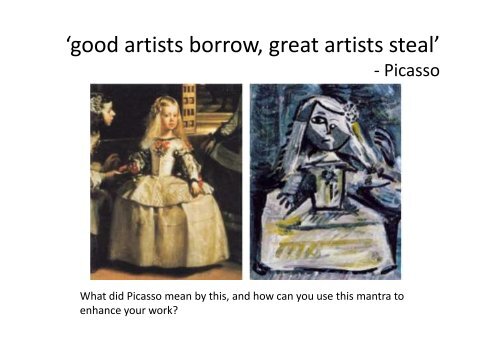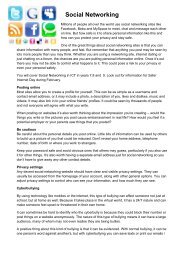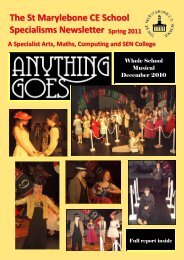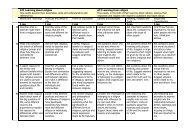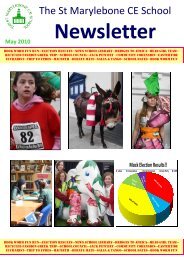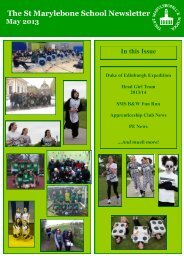'good artists borrow, great artists steal' - St Marylebone School
'good artists borrow, great artists steal' - St Marylebone School
'good artists borrow, great artists steal' - St Marylebone School
Create successful ePaper yourself
Turn your PDF publications into a flip-book with our unique Google optimized e-Paper software.
‘good <strong>artists</strong> <strong>borrow</strong>, <strong>great</strong> <strong>artists</strong> steal’<br />
- Picasso<br />
What did Picasso mean by this, and how can you use this mantra to<br />
enhance your work?
Development - Appropriation<br />
To appropriate something involves taking<br />
possession of it. In the visual arts, the term<br />
appropriation often refers to the use of<br />
<strong>borrow</strong>ed elements in the creation of new<br />
work.<br />
The <strong>borrow</strong>ed elements may include images,<br />
forms or styles from art history or from<br />
popular culture, or materials and techniques<br />
from non-art contexts.<br />
Since the 1980s the term has also referred<br />
more specifically to quoting the work of<br />
another artist to create a new work. The new<br />
work does not actually alter the original per se;<br />
the new work uses the original to create a new<br />
work. In most cases the original remains<br />
accessible as the original, without change.
Picasso<br />
Here, Picasso has appropriated (<strong>borrow</strong>ed, and made his own) the form and subject of<br />
Velasquez’s ‘Las Menias’ to create a new work .
Picasso <strong>borrow</strong>ed from this image more than<br />
once to create new works.
The Chapman Brothers<br />
In 2003, Mark & Dinos Chapman famously bought and then altered a set of Los Caprichos, - a series of etchings<br />
by Goya. Working on top of the original prints (there are several in circulation) they ‘vandalised’ the original<br />
work, by painting on top of it. In doing this, they literally ‘appropriated’ the work of Goya and made it their<br />
own, placing the original in a different context and creating something new.
The Chapman Brothers
The Chapman Brothers
The Chapman Brothers appropriated the<br />
work of Goya more than once… and in a<br />
number of different ways.<br />
Great Deeds Against The Dead<br />
by Jake and Dinos Chapman<br />
(1994)<br />
Goya Disasters of War, 1810 - 20
The Chapman Brothers didn’t only<br />
‘appropriate’ from Goya, they have<br />
also worked on top of a number of<br />
Victorian portraits, ‘defacing’ the<br />
original sitter, by giving them a new<br />
and ghostly disguise.<br />
They also worked into a number of<br />
Hitler’s original drawings for the exhibition<br />
‘If Hitler was a hippie, how happy would he be?’
Other examples of ‘appropriation’ in work by the Chapman Brothers
Richard Prince<br />
In 2005, a Richard Prince photograph of a Marlboro cigarettes advertisement<br />
was auctioned for over $1.2 million - a world record. He photographed the<br />
Marlboro ad without permission removing the identifying marks. In a 1977<br />
essay, Prince proclaimed that he was "practicing without a license" – referring<br />
to his practice of stealing other people's pictures and publishing them as his<br />
own.
Richard Prince
Graham Dolphin Graham Dolphin's work appropriates objects<br />
and icons of the fashion and music industries,<br />
reforming them into assemblages that reveal<br />
the obsessions and formulas underwriting the<br />
temporal world of mass culture.<br />
Text works include: every lyric from the Beatles<br />
back catalogue hand written over the iconic<br />
cover of the White Album. In another text<br />
work, Dolphin takes every word from a single<br />
issue of Vogue and scripts them onto a single<br />
page, which has the same dimensions of the<br />
magazine. Film works include: gathering 1,500<br />
images of Kate Moss merged into 60 seconds<br />
and footage of 100 Fashion Shows shown in a<br />
mere 100 seconds.<br />
These compulsive actions transform and<br />
disrupt the surface aspirations of popular<br />
culture and the glamour industry.
Dolphin's drawings compile every 'product'<br />
(shoes, cosmetics, etc.) traced over each<br />
other onto a single page.<br />
Graham Dolphin
Graham Dolphin<br />
The BOUDICCA Animate Editions are the product of a unique<br />
collaboration between Graham Dolphin and the luxury avantgarde<br />
fashion house.<br />
Dolphin uses the medium of etching to create a series of fine<br />
graphic impressions, which explore the aesthetics of the<br />
BOUDICCA Autumn/Winter collection, Animate.<br />
Edition 1 brings together every item from the collection and reconfigures<br />
the garments into an intensely layered composition.<br />
Edition 2 takes one item from the collection, The Pleated<br />
Shoulder Jacket '(Vent Jacket)', and gathers then explodes all the<br />
different fabrications that have gone into the garment, creating<br />
a deeply transformative representation.<br />
EDITION 1: BOUDICCA ANIMATE COLLECTED (2005)
Graham Dolphin<br />
The series includes two Editions of the<br />
etchings with additional artwork by<br />
BOUDICCA, and a sound art Edition reworking<br />
every piece of music that went into<br />
the New York show launching the collection.
Dolphin’s text works include: every lyric from<br />
the Beatles back catalogue hand written over<br />
the iconic cover of the White Album, every<br />
word from a single issue of Vogue scripted onto<br />
a single page, (which has the same dimensions<br />
of the magazine).<br />
His Film works include: gathering 1,500 images<br />
of Kate Moss merged into 60 seconds and<br />
footage of 100 Fashion Shows shown in a mere<br />
100 seconds.<br />
Graham Dolphin
These compulsive actions appropriate,<br />
transform and disrupt the surface aspirations<br />
of popular culture and the glamour industry.<br />
Graham Dolphin
Fumie Sasabuchi<br />
Sasabuchi's work tends to draw attention<br />
away from the selling purpose of the<br />
advertisements by turning the models into<br />
displays of human anatomy, or by drawing<br />
complex tatoos on children.
Appropriation in painting<br />
The Painting of Modern Life, an exhibition<br />
featured at the Hayward Gallery in London,<br />
(2007) explored the use and translation<br />
(appropriation) of photographic imagery in<br />
modern art.<br />
Beginning in the 1960s when <strong>artists</strong> such as<br />
Warhol, Richter and Artschwager, began<br />
making paintings that translated photographic<br />
images taken from newspapers and<br />
advertisements, the exhibition illustrated how<br />
photography has influenced not just the<br />
content but also the technique of painting.<br />
Andy Warhol, Big Electric Chair, 1967.
Elizabeth Peyton<br />
In most the paintings explored in<br />
this exhibition, photography played<br />
a major part, often as a direct<br />
source material. Some are painted<br />
versions of snatched tabloid<br />
moments rendered in paint, such as<br />
Elizabeth Peyton’s depiction of<br />
Prince Harry at an Arsenal match,<br />
one of the first images to emerge of<br />
the Princes after Diana died.<br />
Elizabeth Peyton, Arsenal (Prince Harry), 1997,
Gerhard Richter<br />
Gerhard Richter’s Woman with Umbrella, a<br />
moving portrait of a distressed woman, is in<br />
fact based on a photograph of a grieving Jackie<br />
Kennedy but could easily be any ordinary<br />
passer-by.<br />
With its basis often in found imagery, Richter’s<br />
work presents a world that is recognisable yet<br />
blurred and slightly out of reach.<br />
“I did not take it [photography] as a subsititute<br />
for reality but as a crutch to help me get to<br />
reality,” a quote by him on the gallery wall<br />
explains.<br />
Gerhard Richter, Woman with Umbrella, 1964,
Liu Xiaodong<br />
Liu Xiaodong’s “A Transsexual<br />
Getting Down <strong>St</strong>airs” (2001)<br />
brings to mind both the<br />
changing state of present-day<br />
China as well as Marcel<br />
Duchamp’s “Nude Descending<br />
a <strong>St</strong>aircase.” Such references<br />
interweave photography and<br />
art history in ways that work<br />
for most of us on a<br />
subconscious level born of an<br />
education in modern art.<br />
Liu Xiaodong “A<br />
Transsexual Getting<br />
Down <strong>St</strong>airs” (2001)<br />
Nude descending a staircase no2 1912 by<br />
Marcel Duchamp
Music is not exempt from appropriation either.<br />
In their music video for their song Lemon, U2<br />
pay tribute to the photographer Muybridge.<br />
Groups such as the Nouelle Vague made their<br />
name by covering (appropriating) songs and<br />
remaking them their own distinctive style.
Rappers & DJs sample and remix<br />
other people’s work – appropriating<br />
the elements they find interesting<br />
in other people’s work and turning<br />
them into something new…<br />
… painters and poets<br />
do the same!<br />
Artists – of all varieties are<br />
constantly referencing each<br />
others work in their own,<br />
remixing and refashioning them<br />
to build new ideas from the<br />
foundations of those which<br />
have gone before them.<br />
What will you do?!
Pop Art<br />
Pop Art was one of the most revolutionary art<br />
movements of the 20th century. In the 1950s,<br />
a group of <strong>artists</strong> in Great Britain and the USA,<br />
rather than despising popular culture, gladly<br />
embraced both its imagery and its methods,<br />
using photographs, advertisements, posters,<br />
cartoons and everyday objects to form the<br />
basis of their art. Their audacity at first<br />
scandalized the Establishment, but by the mid-<br />
1960s their work dominated the world art<br />
scene and names such as Andy Warhol, Roy<br />
Lichtenstein and Robert Rauschenberg were<br />
familiar to many.
Film, art, music, photography,<br />
fashion…<br />
They all look to (and steal) from<br />
each other, you can’t detach<br />
yourself from the world – and<br />
the influences – around you.
Skin & Bones<br />
This exhibition at Somerset House highlighted parallels<br />
between practice in fashion and architecture, showing<br />
how both architects and fashion designers have inspired<br />
one another
Fashion & Architecture<br />
It is often mentioned that<br />
fashion is closely related to<br />
art, but some think the<br />
interconnection between<br />
fashion and architecture is<br />
sometimes even stronger.<br />
Here are five examples from<br />
the spring-collections of<br />
2008 and five famous,<br />
exceptional buildings from<br />
the 20th and 21st century.<br />
Alexander McQueen & Sydney Opera House (by Jørn Utzon)
Balenciaga & Guggenheim-Museum Bilbao (by Frank O. Gehry)
Emilio Pucci & Finca Güell in Barcelona (by Antoni Gaudí)
Akris & Holocaust Memorial Berlin (by Peter Eisenman)
Anne Klein & Unité d’Habitation in Marseille (by Le Corbusier)
‘good <strong>artists</strong> <strong>borrow</strong>, <strong>great</strong> <strong>artists</strong> steal’<br />
- Picasso
Artist appropriation:<br />
project development and artist development writing<br />
• Take inspiration from your <strong>artists</strong> and steal – don’t just<br />
<strong>borrow</strong> from their works and ideas.<br />
• Write about and illustrate the ideas, motifs,<br />
techniques etc you find inspiring in your <strong>artists</strong>’ work<br />
and explain how you’re going to incorporate these<br />
into your work in your artist development writing.<br />
• Ensure you take the concept a step further – there’s no<br />
point in copying something – do something different<br />
with it – take it somewhere else – DEVELOP your ideas<br />
– steal them and make them yours by embedding them<br />
into your work.


